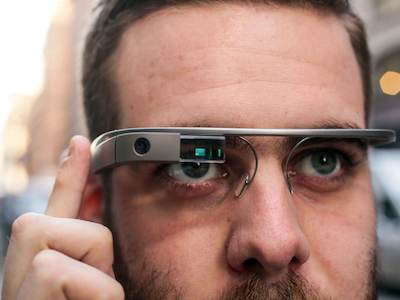Wearables etiquette: How to use your devices without people hating you


In an early edition of Etiquette, Emily Post dissolved the role of the chaperone saying that a young woman could go on a date with a gentleman without supervision. No doubt many parents worried for the purity and reputation of their daughters.
The young folk were probably stoked.
If it weren't for the mutability of what's considered good social behavior, we'd still be sharing quiet dinners with our significant others — and an older scowling relative.
One of the newest ways our standards of manners and etiquette is being tested is through wearable technology. Some are more obvious than others: fitness-focused wearables, like Fitbit or Shine, require less interaction; others like Google Glass, well, require you to talk to yourself and tap the side of your head in public.
But these are early days.
Ideally, wearables should be beautiful and imperceptible, said Sonny Vu, founder of Misfit Wearables. We are, perhaps, not quite there.
That means there's a lot that still needs to evolve. Some of this happens organically. Vu referenced the difference in public cellphone usage between China and Japan. In Japan, it's considered incredibly rude to talk on your phone while riding the subway. In China, nowhere is off limits for a chat.
Some habits, on the other hand, are probably safe to agree upon. Take off Google Glass before you walk into a public bathroom, for example.
Here are some more tips for navigating social and business situations with wearables.
You're the ambassador
Daniel Post Senning of the Emily Post Institute, and author of the book Manners in a Digital World: Living Well Online, advises patience on the part of users of wearables. While technology like Glass still attracts attention, if you have one, he said, "You're one of the vanguard who are introducing these devices or new technologies, and they are going to transform our world."
If the looks and the questions are too invasive, maybe only use the wearable when you're up to it. Fred Steube, senior director of emerging technologies at Cox Target Media sees a difference in comfort between using wearables at an event like SXSW, and everyday, when the distraction can outweigh the value derived from the utility of the device.
Consider the expectations of the situation.
One of the most compelling reasons to think about how you use your wearables is the effect they can have on relationships. Gauge each situation and decide what the particular expectations are. First date? Meeting your significant other's parents? Heartfelt discussion with a friend? Until the day when everyone is sporting wearing something akin to Glass, maybe take a break from your wearable. Turn it off or put it away if it might cause interference, or give the impression that you're not fully attentive.
"We as a culture have too much of this being in the same room or the same social event with somebody and yet being totally checked out," said Gartner analyst Angela McIntyre. Don't let the people you're with feel like you're barely there.
How you're perceived is on you
Think about the gestural cues you're giving off if you're sitting in a business meeting, looking down at your phone. Folks around you would be forgiven for thinking you're texting or answering emails. With many wearables, there's even less of an ability for the people around you to know what you're doing if you're gazing off into your augmented reality or tinkering with your watch.
"It's not up to other people have the right impression of you. It's up to you to manage your image responsibly," Post Senning said. If that means letting people know before a meeting that you really are taking notes and not checking baseball scores on your wearable, do it.
Steube found that even within his company, using his wearables during meetings was too much of a distraction, so he opts to leave them behind.
For Glass, if you want to quash any thought in people's minds that you're using it, you can turn it up on your head or — here's a thought — put it away.
Respect other people's privacy
Perception can also bleed over into privacy.
"People are not so familiar with how Glass works and think they could be videoed at any time," McIntyre said. With so much talk of potential privacy concerns over Glass, why not be as straightforward as possible?
Always ask permission before taking photos and videos of people. Even Google's guide for Explorers said "Standing alone in the corner of a room staring at people while recording them through Glass is not going to win you any friends."
Be better than Pavlov's dogs
One of the reasons it's so hard not to check your phone when it rings or buzzes has to do with programmed behavior. Russian scientist Ivan Pavlov trained his dogs to salivate when they heard a bell ring after spending a set amount of time giving them food after the sound. It's a very similar positive feedback loop, Post Senning said. And that's what we're dealing with with smartphones. Imagine having alerts come in right in front of your face.
"If you're someone who knows your tendency is to pick up the phone when it rings, you have to intentionally train yourself the other way," he said, "Or practice to the point where you've got enough self control."
If you're still in doubt…
As wearables change, and we change along with them, it's good to remember that the behaviors we consider acceptable or unacceptable will shift as well. There is, however, a yardstick for measurement that's timeless. "I love to remind people to return to the principles," Post Senning said. "When they don't know what to do, but really think about what they're doing, they're going to avoid 99 percent of the mistakes people make if they think about what's respectful, what's considerate, and ultimately what's honest."